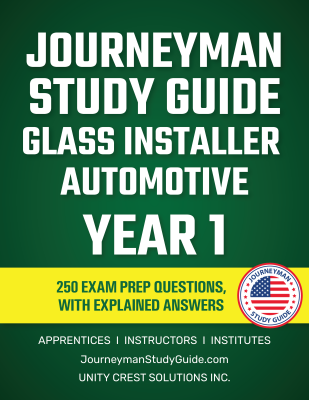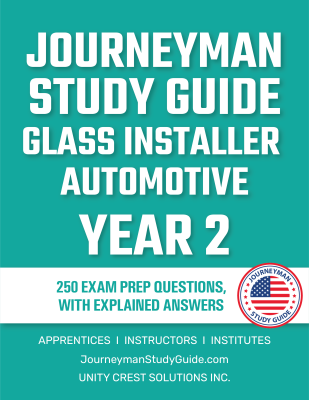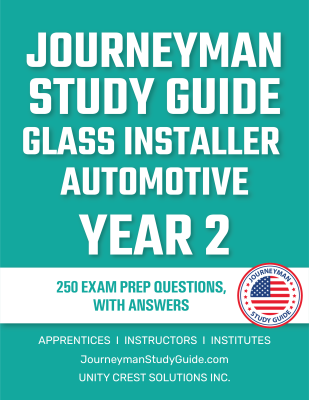Questions, Answers, & Explanations
Get clear explanations behind every answer, perfect for deeper learning and more thorough exam preparation.
Site Updates in Progress: Things might look different as we work on enhancing your experience.
What is a Glass Installer – Automotive?
Glass Installers – Automotive are skilled technicians who specialize in the installation, repair, and replacement of auto glass components such as windshields, side windows, rear windows, sunroofs, and quarter panels. These professionals ensure proper fit, secure bonding, and accurate recalibration of safety systems like ADAS (Advanced Driver Assistance Systems) in modern vehicles.
Working with adhesives, power tools, and high-precision calibration equipment, automotive glass installers are a crucial part of vehicle repair and safety compliance. They’re in high demand across dealerships, collision centers, auto glass chains, and mobile service fleets nationwide.
Key Responsibilities
Automotive glass installers handle a variety of tasks requiring precision, speed, and safety awareness:
Skills and Traits for Success
Top-performing glass installers exhibit a mix of technical expertise, problem-solving, and customer service:
Industries Where Glass Installers Work
Why Choose This Career?
Ready to Start Your Career in Auto Glass?
Prepare with our Online Tests, Q&A sets, and Q/A Explanation guides to master industry standards and ace certification exams.
What to Expect on the Glass Installer Certification Exam
The Glass Installer – Automotive Certification Exam verifies a technician’s knowledge and skills in safely replacing, repairing, and calibrating auto glass to U.S. safety and performance standards. Many employers, including Safelite AutoGlass, Glass America, and collision repair chains like Caliber Collision, require certification through the Auto Glass Safety Council (AGSC) or National Glass Association (NGA).
This certification assures employers and customers that you understand proper installation techniques, safety compliance, and calibration procedures for modern vehicles.
Exam Format
The exam is designed to test both theoretical knowledge and job-readiness:
Key Topics Covered
Passing Requirements
A score of 70% or higher is required to pass most written exams. Some certification programs may require a practical skills demonstration or verified work experience.
Tips for Exam Success
Ready to Get Certified?
Our expertly designed materials help you prepare for success—whether you're aiming for NGA, AGSC, or employer-based certification.
What Types of Questions Are on the Certification Exam?
The Glass Installer – Automotive Certification Exam assesses your understanding of installation procedures, safety standards, tool use, and calibration protocols. Questions simulate real job scenarios and test your ability to meet industry expectations across dealerships, repair shops, and mobile service settings.
Common Question Formats
Sample Questions
1. Safety Standards
Question: According to FMVSS guidelines, what is the required minimum curing time for standard urethane adhesive in 70°F weather before the vehicle can be safely driven?
2. Tool Use
Question: What tool is commonly used to remove the windshield without damaging the pinch weld?
3. ADAS Calibration
Question: What must be done after replacing a windshield on a vehicle with a forward-collision warning system?
4. Installation Math
Question: If you need a 10mm bead of urethane around a 60-inch windshield, how many linear inches will you apply?
Tips for Answering Exam Questions
Get the Practice You Need
Our practice questions mirror real exam content. Use our Q/A Explanation guides and Online Tests to improve accuracy, speed, and confidence.
What Is It Like to Work as an Automotive Glass Installer?
A day in the life of a Glass Installer – Automotive is fast-paced, hands-on, and highly technical. Whether working at a dealership, collision center, or in a mobile repair van, these technicians play a key role in vehicle safety and appearance. Their work ensures windshields and windows are securely fitted, properly sealed, and calibrated for modern safety systems.
Morning: Job Prep and First Appointment
The day usually begins around 7:00 AM at a shop or fleet service hub:
Midday: Installations, Repairs, and Calibrations
This is when most work takes place—often completing 4–6 installations per day:
Afternoon: Final Jobs and Documentation
As the day winds down, installers focus on wrapping up:
Challenges and Rewards
Challenges:
Rewards:
Want to See What This Career Looks Like?
Get job-ready with our study guides, Q&A resources, and Online Tests designed to reflect real working conditions and certification standards.
What Are the Long-Term Benefits of a Career in Automotive Glass Installation?
Automotive Glass Installers enjoy a career that offers steady demand, hands-on work, and strong earning potential. Whether starting at a national brand like Safelite AutoGlass or working for an independent shop, the path forward is clear—specialize, get certified, and move into leadership or business ownership.
Career Progression
Industries and Regions with High Demand
Support from Unions and Associations
Why Pursue Certification?
Build a Career You Can See Through
Use our study guides, Q&A tools, and Online Tests to start strong and grow your career as an automotive glass installer.
How Much Can You Earn as an Automotive Glass Installer?
Automotive Glass Installers in the United States enjoy steady pay with opportunities to increase earnings through certifications, mobile work, and ADAS calibration specialization. As vehicle glass becomes more complex, skilled installers are in high demand—especially in regions with high population density, heavy traffic, or frequent storm damage.
General Wage Ranges
Regional Pay Variations
What Impacts Earnings?
Increase Your Earning Power
Use our Online Tests, Q&A sets, and Q/A Explanation study tools to become certified, sharpen your skills, and qualify for higher-paying roles in the auto glass industry.
What Tools and Resources Do Automotive Glass Installers Use?
Success in the auto glass industry depends on using the right tools, materials, and learning resources. Whether you’re performing a mobile windshield replacement or calibrating forward-facing cameras, your ability to work efficiently and safely is built on high-quality gear and updated knowledge.
Essential Tools for Auto Glass Technicians
Recommended Learning Resources
Why the Right Tools and Training Matter
Precision, safety, and speed depend on proper tools and up-to-date training. Investing in your equipment and education helps you deliver higher-quality work, gain client trust, and move up in your career.
Equip Yourself for Success
Master every tool and technique with our study guides, Q&A products, and Online Tests—built for today’s automotive glass technician.
Where Can You Learn to Become an Automotive Glass Installer?
Training for a career as an Automotive Glass Installer in the U.S. is available through trade schools, union apprenticeships, manufacturer-backed programs, and specialized glass academies. These programs prepare technicians to meet current safety standards, handle modern vehicle technology, and perform precise installations and calibrations.
Types of Education Programs
What You'll Learn
Choosing the Right Program
Get Trained, Get Hired
Pair your education with our Q&A products, Q/A Explanations, and Online Tests to master skills and pass your certification exam with confidence.
Why Join a Union or Work with Top U.S. Employers?
Whether you’re installing windshields in a dealership or operating a mobile glass unit, working with a union or leading employer can unlock higher pay, better benefits, and long-term job security. Unions provide training and representation, while national companies offer structured career paths and cutting-edge tools.
Benefits of Union Membership
Leading American Unions
Top Employers for Automotive Glass Installers
How to Connect with Employers
Make the Right Connections for Your Career
Use our study guides, Q&A products, and online tests to gain certification and qualify for the best union and employer opportunities.
How to Stay Ahead in the Auto Glass Industry
The automotive glass industry in the United States continues to grow and evolve with advancements in vehicle safety technology, materials, and installation techniques. Staying current with tools, certifications, and trends is essential for long-term success as a Glass Installer—Automotive. From ADAS calibration to new adhesive systems, skilled technicians are more valuable than ever.
Key Trends in the Industry
Best Practices for Career Growth
Opportunities & Challenges
Opportunities:
Challenges:
Stay Certified, Stay Competitive
Whether you're just getting started or advancing your auto glass career, staying current with training, tools, and certifications will keep you competitive in the evolving U.S. market.
Prepare with our study guides, Q&A sets, and interactive online tests to build the knowledge you need—on the job and for certification success.
Get clear explanations behind every answer, perfect for deeper learning and more thorough exam preparation.
Quick and easy practice to test your knowledge anytime, anywhere—ideal for simple, on-the-go preparation.










